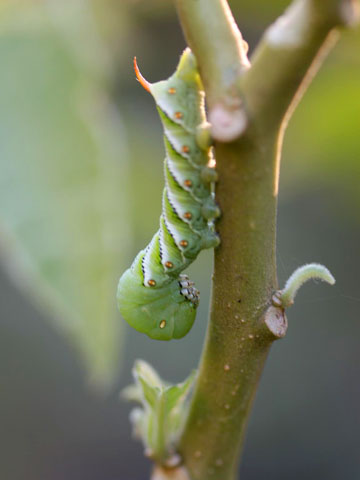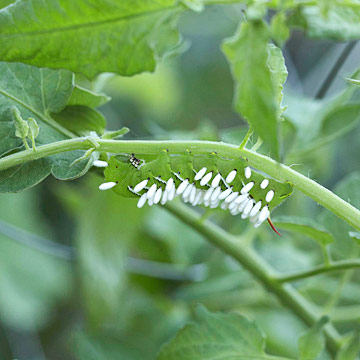






Tomato and tobacco hornworms are large green caterpillars (up to 4 inches long) that feed on tomato plants. Tomato hornworms are more common in the North, while tobacco hornworms are more likely in the South. In addition to tomato, they feed on closely related plants, including tobacco, eggplant, pepper, and potato.
Identifying the Pest
Hornworms get their name from the prominent "horn" on their rear end. The tomato hornworm has a black horn and eight yellow or white V-shape marks on its side. The tobacco hornworm has a red horn and seven angled white stripes on its side. Because they are green and blend in with plant foliage, gardeners often don't see hornworms until they have grown large and caused significant defoliation from their feeding. They usually eat leaves, but may chew on developing fruits, too.
The adult is a brownish moth, variously known as a hummingbird moth, sphinx moth, or hawk moth. If you see grayish brown moths with thick bodies hovering over plants, be on the lookout for eggs and small larvae. Eggs are oval and light green to white. Young larvae look just like older worms, except they are smaller.
Click here to learn natural ways to control garden pests.
continue reading below
Cultural Controls If hornworm larvae are several inches long when first noticed, handpicking and destroying them is the most effective control. Squeamish gardeners can use gloves to handle the worms.
Biological Controls Several natural predators and parasites keep hornworms in check. Ladybugs and lacewings feed on hornworm eggs and immature larvae. Parasitic wasps attack all stages of larvae. A type of braconid wasp lays its eggs in hornworms. The eggs hatch and the developing wasps feed on the inside of the hornworm until the wasps are ready to pupate. The cocoons appear as white spindles attached to the upper side of the hornworm. Leave these parasitized hornworms in the garden. The wasps will emerge from the cocoons and attack other hornworms.
The bacterial insecticide Bt (Bacillus thuringiensis) controls young larvae but is less effective on mature hornworms. Spinosad is another organic insecticide that will control young larvae. Carbaryl and permethrin are other chemical options for control of hornworms.
Copyright © www.100flowers.win Botanic Garden All Rights Reserved